Excerpted from Beyond the Great Wall by Jeffrey Alford and Naomi Duguid.
My first introduction to these noodles was in Serik’s sister’s yurt. It was one of several yurts set up somewhat haphazardly in a large open field, close to a large construction project. The project, which appeared near to completion, was a government hotel venture in Kanas Lake National Park. The hotel looked a little bit like a Colorado ski area, with a fancy lodge and many surrounding condos, but it was not yet up and running.
The Kazakh yurts were a definite contrast. I assumed that the yurts were there for the project’s workers, but I’m not sure. I rode up on the back of Serik’s motorcycle, and when his sister came out and discovered that he had been in a motorcycle accident (his face and hands were badly scraped), there wasn’t a lot of small talk. She was furious with him because, after all, Kazakhs ride horses, not motorbikes! We all went into the yurt and drank hot salty tea, and they talked back and forth in Kazakh. Someone came in from another yurt, and the whole story of the crash was told again, and there were more loud words, not angry, just deeply felt.
And all the while, Serik’s sister cooked. She had a pressure cooker on the wood-burning stove at one end of the yurt, and bits of goat shank were cooking away in a broth. She briefly kneaded an egg noodle dough on a small table, then stretched the dough out into several long thick strips, each a foot and a half long, 4 inches wide, and about ½ inch thick. She cut them crosswise into H-inch-wide strips and covered them with a cloth until the broth finished cooking.
When the broth was done, she took out the meat and bones and then deftly stretched the dough strips into noodles by hand, one by one, tossing each into the broth once it was stretched. Almost instantly, it seemed, she had all the noodles formed and cooking. She made it look incredibly easy. When they were al dente, she strained the noodles from the broth, piled them on a large platter, and sliced a raw onion on top. She put the big pieces of bone (with a smattering of meat) on top, and we all dug in. We ate with our right hands only, as is the rule in Islamic cultures when eating by hand. About midway through the meal, she poured the broth into small soup bowls, and we drank it alongside the noodles.
As we ate, the tone of the conversation relaxed a bit. Everyone was alive. And we were eating good food, great food. I got to enjoy these noodles several more times in Kazakh homes, and as soon as I was back home in Toronto, I started trying to make them. We’ve been playing around with this recipe for three years now. It’s been one of those food encounters that is both humbling and exhilarating. There are mysteries, but that makes playing with them all the more fun. Sometimes the dough is easy to work with, sometimes not. But we always come out with noodles, and they always taste great.
You can make the noodles shortly before you want to cook them or make them as long as several days ahead and hang them to dry. It’s just a matter of what is most convenient for you. The dough should be made at least half an hour, or as long as 2 hours, before you want to shape the noodles.
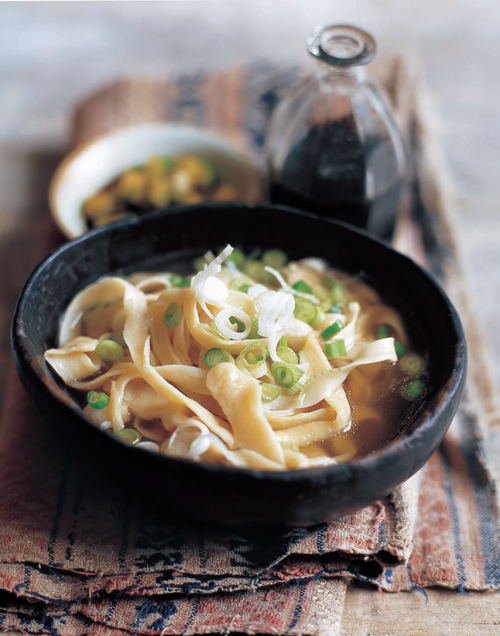
Kazakh Noodles
Ingredients
- 3½ cups all-purpose flour, preferably unbleached, plus extra for surfaces
- 1 teaspoon salt
- 2 large eggs
- About ¾ cup lukewarm water
- About 8 cups broth (homemade preferred)
Instructions
At least an hour before you want to serve the noodles, place the flour, salt, and eggs in a food processor and process briefly. With the blades spinning, slowly pour the lukewarm water through the feed tube until a ball of dough forms (you may need slightly less or slightly more than ¾ cup). Turn out onto a lightly floured surface and knead briefly.
Alternatively, place the flour, salt, and eggs in a medium bowl and whisk or stir to combine them. Add ¾ cup lukewarm water and stir to mix it in. If the dough is still dry or stiff, mix in a little extra water. Turn out onto a lightly floured surface and knead until smooth, about 3 minutes.
Cut the dough into 4 equal pieces on a lightly floured surface. Flatten each piece under the palms of your hands into a rectangle approximately 12 inches long and 3 to 4 inches wide. Use a sharp knife or a metal dough scraper to cut the rectangles crosswise into strips just under ½ inch wide.
Cover the dough with a cloth or plastic wrap and let rest for at least 30 minutes, or for as long as 2 hours.
Before starting to stretch the noodles, lightly dust a large work surface with a little flour. You will then be able to dust the stretched noodles with a little flour to keep them from sticking, and you can lay the stretched noodles on the floured surface when they’re shaped. (You could instead drape them on a rack or over the back of several wooden chairs.)
Stretching the dough the Kazakh way is amazingly easy. Our description of the technique may look long, but once you pick up a piece of dough and see how it yields and thins with the pressure of your fingers and thumbs, you’ll find your own technique. We often make these with one of our kids or with a guest, so the work goes quickly, and everyone gets to practice noodle stretching. Pick up a dough strip and touch both sides of it to the floured surface, then pinch it gently near one end between the thumb and forefinger of one hand, holding it nearer the center with the thumb and index finger of your other hand. You’ll be stretching it both by pinching it along its length and by pulling the pinched section gently away from where you’re holding it in your other hand. Gradually work your way along the strip, pinching it and gently pulling your hands apart a little as you do, to flatten and stretch it. When the strip is 12 to 15 inches long, touch it again to the floured surface to dust it with flour, then lay it to one side of the floured surface.
Repeat with the remaining dough strips. Once all the noodles are shaped, bring the broth to a vigorous boil. Add the noodles, bring back to a boil, and cook until tender but still firm to the bite, about 6 minutes.
Use a mesh basket or tongs to lift the noodles out of the broth and into wide individual soup plates. Ladle broth over the noodles, and serve.
Makes a generous l½ pounds noodles; serves 4 as a main course, 6 as a hearty soup course.

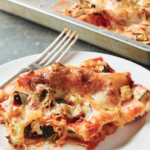
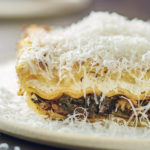
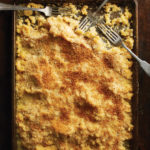
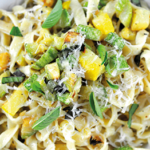
No Comments